|
 Gymnopilus crociphyllus Gymnopilus crociphyllus
SynonymsAgaricus crociphyllus
Agaricus xanthophyllus
Flammula crociphylla
Flammula xanthophylla
Agaricus penetrans
Flammula penetrans
Agaricus rutilans
Tricholoma rutilans
Agaricus fusus
Flammula fusa
BiostatusPresent in region - Indigenous. Non endemic
Images (click to enlarge)
Caption: 118-Gymnopilus crociphyllus [Flammula fusa]: a. spores; b. spores. | 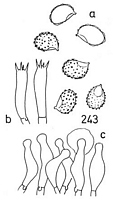
Caption: 243-Gymnopilus sp. [Flammula penetrans]: a. spores; b. basidia; c. cheilocystidia. | 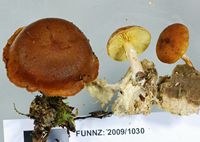
Owner: J.A. Cooper | 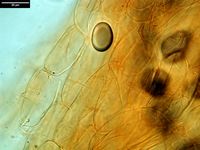
Caption: cap hyphae (Melzers)
Owner: J.A. Cooper | 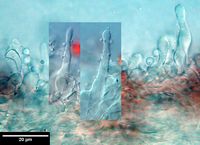
Caption: Cheilocystidia (Melzers)
Owner: J.A. Cooper | 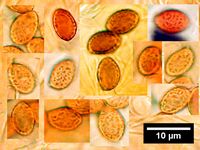
Owner: J.A. Cooper | 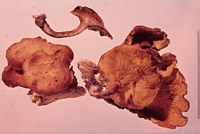
Owner: Herb. PDD | 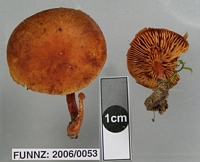
Caption: FUNNZ: 2006/0053, See public note for more information
Owner: FUNNZ | 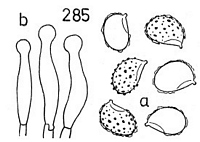
Caption: 285-Gymnopilus crociphyllus [Tricholoma rutilans]: a. spores; b. cheilocystidia. |
Article: Horak, E. (1971). A contribution towards the revision of the Agaricales (Fungi) from New Zealand. New Zealand Journal of Botany 9(3): 403-462 (http://www.rsnz.org/publish/abstracts.php).
Notes: Flammula crociphylla Cooke and Massee (= Fl. xanthophylla C. &
M.) (13 D, 11, 16)
Article: Massee, G.E. (1899) [1898]. The fungus flora of New Zealand. Transactions and Proceedings of the New Zealand Institute 31: 282–349 Wellington:.
Description: Pileus subglobose, then broadly expanded but the margin persistently incurved, ochraceous or
with a tinge of primrose-yellow, glabrous at first, then broken up into minute innate
squamules or cracked in an areolate manner, 2.5-7 cm. diameter; flesh thick, compact, rigid
when dry; gills adnate, with a decurrent tooth, rather distant, very broad, bright-yellow, then
with a rusty tinge; spores elliptical, 10 x 6 µ; stem distinctly excentric or lateral, about 2.5
cm. long, stout, solid, more or less striate, coloured like the pileus, or paler.
Habitat: On wood.
Distribution: Dannevirke, New Zealand, Australia.
Notes: A very distinct and well-defined species, known by the broad clear-yellow gills and excentric
stem.
Article: Massee, G.E. (1899) [1898]. The fungus flora of New Zealand. Transactions and Proceedings of the New Zealand Institute 31: 282–349 Wellington:.
Description: Gregarious or caespitose ; pileus convex, then plane, obtuse, often irregular, even, glabrous,
surface not becoming broken up, dry, minutely silky under a lens when young, golden-tawny,
but becoming pale and yellowish when old, 4-8 cm. across; flesh pallid, thickish at the disc,
thinning out towards the margin; gills adnate and subdecurrent when young, often separating
from the stem when old, 4-6 mm. broad, crowded, white, then yellow, stained and spotted
with brown when old; spores elliptical, obliquely apiculate, 8 x 4-5 µ; stem 5-8 cm. long, up
to 1 cm. thick, firm, equal, silky, then fibrillosely-striate, yellowish, base with white down,
sometimes rooting, imperfectly hollow; veil flocculose, white, but very fugacious and
scarcely evident.
Habitat: On rotten wood.
Distribution: Dannevirke, New Zealand. Australia, Europe, Siberia, Cuba, United States.
Notes: A very showy fungus, distinguished in the genus by the clear tawny-orange pileus and yellow
gills becoming spotted with brown.
Article: Horak, E. (1971). A contribution towards the revision of the Agaricales (Fungi) from New Zealand. New Zealand Journal of Botany 9(3): 403-462 (http://www.rsnz.org/publish/abstracts.php).
Notes: Fig. 20 Under this name four collections can be found at Kew: the material
labelled (COLENSO b 70) belongs to an undescribed species of Gymnopilus
which grows mainly on rotten wood of Leptospermum. The other three collections
(COLENSO b 51, b 210, b 311) represent Gymnopilus crociphyllus (Cooke and
Massee) Pegler. Spores oval, with distinct smooth plage, otherwise warted, rust-brown, 5-6 X 3.5-4 µ.
Article: Massee, G.E. (1899) [1898]. The fungus flora of New Zealand. Transactions and Proceedings of the New Zealand Institute 31: 282–349 Wellington:.
Description: Pileus ovato-globose, obtuse, with the margin incurved, and entirely covered with a dense
unbroken coating of dark-purple or reddish-brown velvety nap, when young; when older
becoming campanulate and often umbonate, purple, all one colour; at maturity expanded,
often umbonate, the cuticle broken up into small purple innate fascicles of down on a yellow
ground; always dry, 6-14 cm. diameter; flesh thick, soft, deep-yellow from the earliest stage,
becoming golden-yellow when broken; gills broadly adnexed, yellow from the first, crowded,
edge thickened, floccose, and deeper yellow than the rest of the gill; spores subglobose, 5-6 µ
diameter; stem 5-9 cm. long, up to 2 cm. thick, fleshy, imperfectly hollow, soft, rather
bulbous when short, ventricose when elongated, yellow, variegated, especially upwards, with
purplish floccose squamules.
Habitat: On the ground.
Distribution: New Zealand. Australia, Europe, United States.
Notes: Inodorous ; size very variable. Readily distinguished by the yellow flesh and gills.
Article: Horak, E. (1971). A contribution towards the revision of the Agaricales (Fungi) from New Zealand. New Zealand Journal of Botany 9(3): 403-462 (http://www.rsnz.org/publish/abstracts.php).
Notes: Tricholoma rutilans (Fries) (8,16) Fig. 24 = Gymnopilus crociphyllus (Cooke
and Massee) Pegler
All characters of this collection (COLENSO b 972) correspond well with the type.
It occurs both in Australia and New Zealand.
Article: Horak, E. (1971). A contribution towards the revision of the Agaricales (Fungi) from New Zealand. New Zealand Journal of Botany 9(3): 403-462 (http://www.rsnz.org/publish/abstracts.php).
Notes: Flammula fusa (Batsch) (6) Fig. 11 = Gymnopilus crociphyllus (Cooke and
Massee) Pegler 1965.
In spite of the fully destroyed specimen (COLENSO b 243), we are quite
convinced that the residual rust-brown, warted spores with a distinct, smooth
plage (6-8 X 4-5 µ) are those of the above species. This Gymnopilus is one of the
most common agarics in New Zealand.
|